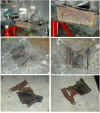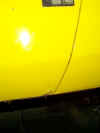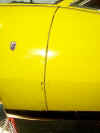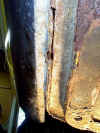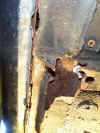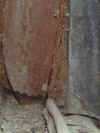In the seventies the idea of heavy proactive corrosion prevention was not a big priority for any of the car manufacturers. This was especially true with monocoque body construction used in the exotic cars like the de Tomaso Pantera.
The monocoque body was difficult because the number of parts welded together to form the car structure creates lots of places for water to collect. During this time none of the manufactures coated the inside areas of the parts with corrosion preventive materials. As water collected in enclosed areas it could really do a great job of destroying a car.
Some corrosion on a normal "frame and body" type car might not present any problem but with a monocoque body it can be very bad and expensive. On the monocoque body most areas of the car are part of the structure or "frame" of the car so corrosion in the wrong place can impact the drive train and suspension of the car. But as far as I know from reading all of the information I can find about the Pantera there are no documented cases of the drive train or suspension of the car falling off because of corrosion.
The other problem is that I donít think de Tomaso (or anyone else) expected that in the year 2000 people would be driving around in their Panteras with 500 HP engines and doing 180 mph (not me). For sure Ford was surprised to find the buyers of the Panteras liked them a lot and werenít going to part with their "babies". Rather than fixing the early corrosion problems on the Pantera Ford thought they would just buy them back, wrong! Ford got to fix a number of cars. I understand that Pantera International was a very big driving force with Ford in the late seventies to get the Panteras fixed. Most of the worst problems were found on cars that had been driven on salted roads. After living in Iowa for a couple of years (93-94) I can see why, even the newest cars have problems with salt.
The Pantera is no better or worse than the other monocoque bodied cars of the seventies. When I was looking for my car I saw some great cars and some not so great corroded cars.
The drawings above show the common areas of the Pantera that could have corrosion problems. The red areas highlight places where corrosion is most serious (potential for structural failure) and the yellow areas highlight where corrosion could be but would most likely not be a big problem unless it was extensive. All of this information is impacted by the geographic location or area where the car has been driven or stored.
Keeping the water drain holes along the bottom of the doors and rocker panel pinch weld drains is important. Some people drill drain holes in the bottom of the rear tubes that are the supports for the A arm mounts (see red area on drawing) and in the bottom of the back sub frame rails.
The area around the lower front valance is a great water trap and often the front cross member and pinch weld in this area can be a problem but usually it's smashed from hitting stuff. The front vertical edge of the front hatch and the back lower edge of the back hatch can be problem areas but this is usually only cosmetic although a new front or back hatch is very expensive.
Mike Drew
The following was sent in by Mike Drew. Mike's information and photos are an excellent example of what you DO NOT want happening to your Pantera.
Many people are in the market for Panteras and hear all the horror stories about chassis rust, but aren't really sure what it looks like, or where to find it. Here is a compilation of six photographs of a rusty Pantera (not mine--mine was worse!) This car has MAJOR chassis rust which has seriously impacted its structural integrity--this car is unfit for the road in its current state. Only after comprehensive repairs have been conducted would I consider setting foot in this particular car--fortunately said repairs are well underway and should be complete in the next few months.
Image of a very corroded inner wheel house. Click image to view.
The top left photo shows the driver's side inner wheel house, with the rusty portions cut out for replacement. Top right shows the chassis rail underneath, which was seriously compromised by water trapped in the inner wheelhouse tubes and layered sheet metal. The remaining four photos show different views of the cut-out piece. Note that the tubes are so thrashed, that it would be fairly simple to crush them with your bare hands. THIS is the single most important place to seek out rust in any Pantera, whether you own it or are considering buying it.
Although it's a fair bit of work to repair, it's not necessarily terminal. But just like cancer, early detection is the key. Advanced stages can still be brought to a successful recovery, but it takes much more work, commitment and $$$$.... Also, where there's smoke, there's fire. Meaning, if a potential seller alerts you to rust in one area, you can bet your bottom dollar that rust to a similar degree exists elsewhere. For example, although at first glance it seems fine, this car has wasted rocker panels, front valance and radiator support, and probably high degrees of rust elsewhere in the chassis which will all have to be dealt with before the car can really be considered sound.
FWIW, this car has an almost perfectly straight body and shows few, if any signs of rust in any of the sheetmetal. So don't assume that a nice straight body and quality paint automatically equates to a solid chassis. Caveat emptor... Mike Drew
Mike Drew
The following images were sent by Mike Drew and show the location of drain holes that should be drilled the the lower part of the wheel house frames to help water drain out and reduce corrosion problems.
Robert King
The following image was sent in by Robert King showing the driver's side inner wheel house on his car before it was repaired. This is the only rust problem Robert has found on his car. If water drain holes had been drilled in the bottom of the frame tubes when the car was new this damage would most likely been prevented. This is all repaired now and the car is on the road and Robert is having a blast driving his newly acquired Pantera.
Click image to view
Ken Green
The following images were sent in by Ken Green of San Clemente, CA. The owner of this Pantera is unknown but the images give good insight on some tough corrosion problems. It looks like the car was driven all of its life in an area that used heavy road salt.
On the left, the driver's door. Center, the area in front of the driver's door. On the right, the front trunk.
The first three images, the view looking down into the engine bay area. The last image on the right, the view looking up into the engine bay from under the car.
Miscellaneous images of the rockers, seam between the rockers and floor pan and the front sub frame under floor pan.
Image of the engine compartment looking at the diver side rear door pillar with the gas tank removed.
Dave Doddek sent in the following: OK, Super Genius Dave can identify this spot. Turn it 90 degrees to the right so that the right hand side is the bottom (this was done, ED). This is a view of the door latch pillar area at the bottom edge viewed from the back with the gas tank removed. The odd ridge on the right side is actually the rubber molding that sits under the gas tank protecting it from the lip where three sections of metal in the rocker are welded together. You can identify this area by the rounded left edge of the vertical support.



